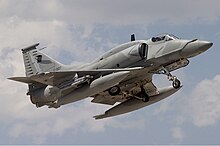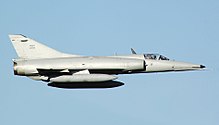Fuerza Aérea Argentina
|
Fuerza Aérea de Argentina |
|
|---|---|
| Lineup | January 4, 1945 |
| Country |
|
| Type | Armed forces ( air forces ) |
| Strength | 14,600 |
| insignia | |
| Aircraft cockade |
 
|
| National emblem ( vertical stabilizer ) |
|
The Fuerza Aérea Argentina (FAA) are the air forces of the Republic of Argentina and the second of three branches of the armed forces of Argentina . It is led by Brigadier General Normando Costantino and with 21,560 members, two thirds of them soldiers (as of 2007), is larger in terms of staff than that of neighboring Chile, but compared to the Fuerza Aérea de Chile its equipment is outdated.
history
The history of military aviation in Argentina goes back to the 19th century, when a balloon captured by the Brazilians on July 6, 1866 in the Triple Alliance War was used again for enemy observation by Argentina. The first organization exclusively serving (civil and military) aviation was the Aero Club Argentino, founded on January 13, 1908 . The father of military aviation in the country was subsequently Jorge Newbery, who became known for his exploration and expedition flights. In 1922 the 'Flugstützpunkt number I' (Grupo number I de Aviaion) was established in El Palomar . The 1920s were also characterized by long-distance and record flights; The Fábrica Militar de Aviones and the 'Instituto Aérotecnico' were established in Cordoba in 1926/7.
With the establishment of the Comando en Jefe de Aeronáutica on February 11, 1944, the establishment of an independent air force began in Argentina, and on January 4, 1945, the Fuerza Aérea Argentina was established as an independent and third branch of the armed forces. After the World War, German pilots and developers played a decisive role in building the FFA. Between 1948 and 1954, the German ace flying Adolf Galland was an advisor to the Argentine Air Force under the then President Juan Perón. The aircraft designer Kurt Tank and his team of engineers were in Córdoba from 1947 to 1955 and developed the jet fighter FMA I.Ae. 33 Pulqui II. After Peron was overthrown, the German specialists left the country again.
In the 1950s, the FAA began flying the flag in Antarctica, and as a result, two permanent bases, Matienzo and Marambio, were established in 1961 and 1969. While Argentina continued to focus on Antarctica in the 1970s, the following decade was dominated by the war over the Falkland Islands , a territory of the United Kingdom claimed by Argentina . Due to the blockade of the islands imposed by Great Britain after the Argentine invasion in April 1982, the invading forces were largely left to their own devices. The FAA had some Pucarás stationed on the islands, but their jet fighter and those of the Navy could only be used from the distant mainland, a decisive disadvantage compared to the British sea-based aircraft . This lost war has noticeable consequences until today (2010). Most of the combat and transport machines that were in active service in 2010 were (or were) from before the war.
Since the end of the military dictatorship , the FAA has been used in a number of UN peace missions in the Americas, the Balkans and Cyprus, the Middle East and Africa.
In spring 2015, negotiations with China about the purchase of a fighter aircraft were announced, which should be either the Chengdu J-10 B or the Chengdu FC-1 .
equipment
Overview, as of the end of 2010
Planes
- Warplanes
- 6 Mirage IIIEA , interceptor (now out of service)
- 23 A / OA-4AR Fighting Hawk , fighter-bomber
- 5 Mirage 5P Mara , fighter-bomber (now out of service)
- 10 fingers , fighter-bomber
- 31 IA-58 Pucará , attack aircraft
- EMB-312A Tucano ground attack aircraft
- Reconnaissance aircraft
- Bombardier Learjet LJ-35A , photo reconnaissance and measuring aircraft
- Tanker and transport aircraft
- 2 Lockheed KC-130H Hercules tanker aircraft
- 6 Lockheed C-130B / H / L-100 Hercules tactical transporters
- 1 757-23A , VIP transport plane
- 7 DeHavilland Canada DHC-6 Twin Otter liaison aircraft
- 5 F-27 Friendship , transport aircraft
- 0 Airbus C-295 , transport aircraft, 2 planned as F-27 replacements
- 5 F28-400 Fellowship , VIP transport aircraft
- SAAB 340B , transport aircraft
- 0 Embraer KC-390 , tactical transporter (6 planned)
- Training aircraft
- 4 TA-4 two-seat fighter aircraft
- 3 Mirage IIIDA two-seat combat aircraft
- 19 AT / IA-63 Pampa (10 more ordered) Advanced trainers
- 0 T-6C + Texan II advanced trainer, 12 as a Tucano replacement since 2017
- B-45 mentor , basic trainer
- Su-29 aerobatic machines belonging to the Cruz del Sur aerobatic team
helicopter
- Bell UH-1D , transport helicopter
- 5 Bell 212 transport helicopters
- 12 MD 500D / E
- 0 Mi-17 , multipurpose helicopters (2 ordered)
- 1 S-70 A30 , VIP helicopter
- 2 SA315 Lama , light multipurpose helicopter
bases
The FAA has stationed on the following airports flying associations, except for the the Training Command ( Comando de Educación ) below flight school in Córdoba, the courts are subordinate to the Operations Command ( Comando de Operaciones Aéreas ).
- Base Aérea Militar El Palomar, El Palomar , Province of Buenos Aires , Iª Brigada, Air Transport Base (C-130, F28)
- Base Aérea Militar Paraná, Paraná , Entre Ríos Province , IIª Brigada, transport aircraft base (Learjet, F-27)
- Base Aérea Militar Reconquista, Reconquista , Santa Fe Province , IIIª Brigada Aérea, Attack Air Base (IA-58, EMB-312)
- Base Aérea Militar El Plumerillo , Mendoza , Province of Mendoza , IVª Brigada Aérea, space for advanced trainers and base of the Cruz del Sur aerobatic team (IA-63, SA315, Su-29)
- Base Aérea Militar Villa Reynolds, Villa Reynolds , San Luis Province , Vª Brigada, Fighter Aircraft Base (A-4)
- Base Aérea Militar Tandil, Tandil , Province of Buenos Aires, VIª Brigada Aérea, Fighter Aircraft Base (IA-63)
- Base Aérea Militar Moreno, José C. Paz, Province of Buenos Aires, VIIª Brigada Aérea, helicopter base (Bell 212/412, MD500, Mi-171)
- Base Aérea Militar Comodoro Rivadavia, Comodoro Rivadavia , Province Chubut IXª Brigada, Air Transport Base (DHC-6, Saab 340)
- Escuela de Aviación Militar Córdoba, Córdoba , Province of Córdoba , Training and Flight Test Center (G-120, T-6C +, P2000 Sierra, IA-63, B45)
There are also some other bases such as
- Base Aérea Militar Mar del Plata, Mar del Plata , Buenos Aires Province
- Base Aérea Militar Río Gallegos, Río Gallegos , Santa Cruz Province
- Base Aérea Militar Morón, Morón , Buenos Aires Province
The FAA operates bases in Antarctica, which are also available to other government agencies in Argentina.
- Base Antártica Marambio
- Base Antártica Matienzo
Further units of the training and the other command as well as other offices are located at other locations. Mention should also be made of the state president's readiness to fly , Agrupación Aérea Presidencial , which is spread over the El Palomar and Buenos Aires-Jorge Newbery airports .
Web links
- FAA homepage (Spanish)
Individual evidence
- ↑ a b Adolf Galland : The First and the Last , (first edition 1953; here: Flechsig Verlag 2012, p. 11)
- ↑ Jane's Information Group : China's J-10 advocated as Argentine 'Typhoon beater' ( Memento from February 17, 2015 in the Internet Archive ), accessed on February 16, 2015
- ↑ Argentina is looking for a successor to Tango 01. In: Aerotelegraph. September 20, 2016. Retrieved September 20, 2016 .


